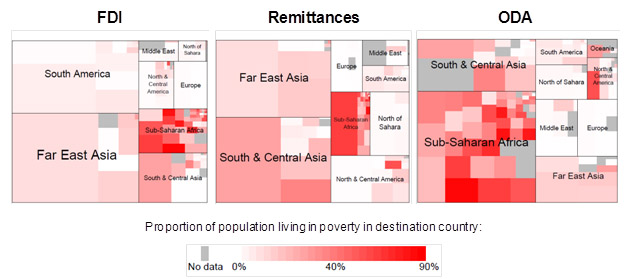International resource flows have grown rapidly to developing countries
International resource flows doubled from 2000 to 2012, rising to US$2.1 trillion across all developing countries. Much of this growth has been driven by rising FDI, lending and remittances.
However, many of these flows are concentrated in just a few developing countries
Resources are concentrated in a small number of countries: two-thirds of FDI to developing countries goes to just 10 countries, while half of all remittances go to just five countries.
The true picture is even more complex: large flows leave developing countries and some ‘inflows’ are in fact sourced domestically
Although large amounts of finance flows into developing countries, they also flow out. Large amounts leave developing countries each year – most are not productive investments in the rest of the world but repayments on loans, outgoing profits on FDI or illicit finance.
The bundle of some resources such as FDI is varied and complex. For example, a large proportion of FDI does not involve cross-border transfers: over 75% of US and 85% of UK investment in Africa in 2012 was funded by the reinvestment of profits made in the ‘destination’ country.
ODA is the most ‘poverty-sensitive’ resource flow
In all, 45.2% of ODA goes to countries with above average poverty rates, compared with 37.4% of remittances and 13.4% of FDI. ODA agencies with a legal mandate to target poverty reduction allocate 80% of ODA to countries with above average poverty rates.
Figure 4: International financial flows to developing countries
Source: Development Initiatives calculations based on OECD, UNCTAD, World Bank; excludes regional flows
Poor data on resources limits their contribution to coordinated implementation
The data describing many resource flows is insufficient to answer even basic questions about their scale, characteristics or potential impact on sustainable development and poverty. Data are often untimely and lack details such as sector breakdown, the financing instrument used, or outflows associated with inflows. Even in ODA, which has seen sufficient improvements in data, there remain a number of important issues that cannot be understood with current data, such as sub-national spending or the ability of ODA to mobilise domestic resources and/or the private sector.
Without significant improvements in data on resource flows, it will be difficult to effectively mobilise the contributions of diverse actors within the post-2015 implementation framework, and for the international community to monitor their impacts.
